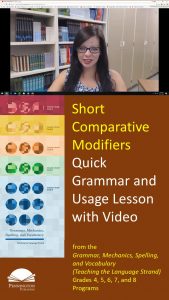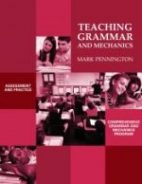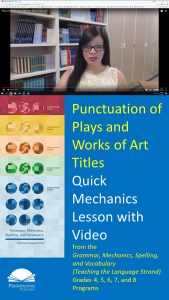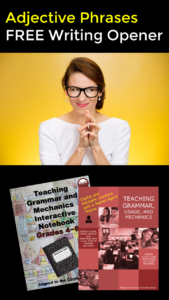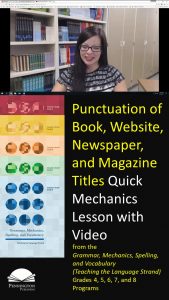Short Comparative Modifiers
Short Comparative Modifiers
Play the quick video lesson HERE and click the upper left back arrow to return to this lesson.
Common Core Language Standard 1
A comparison means to find the similarities or differences between two or more things. Sometimes we use the word contrast to find just the differences, so teachers may say “Compare and contrast these two plots,” but the word compare can mean what’s the same and what’s different, so “Compare these two plots” really means to do the same task. When we use the term comparative modifier, we mean comparing only two nouns or verbs. We use superlative modifier when comparing three or more nouns or verbs.
Today’s grammar and usage lesson is on short comparative modifiers. Remember that an adjective modifies a noun or pronoun and answers Which one? How many? or What kind? An adverb modifies a verb, an adjective, or an adverb and answers What degree? How? Where? or When?
Now let’s read the grammar and usage lesson and study the examples.
A modifier is an adjective or adverb that limits the meaning of a word or words. Use the suffix “_er” for a one-syllable modifier to compare two things. Example: fewer than five
Use “_er” or more (less) for a two-syllable modifier to compare two things. Example: prettier, more often
Now circle or highlight what is right and revise what is wrong according to grammar and usage lesson.
Practice: Mike appears more smart than Ken, but Mike is really just more careful with his work.
Let’s check the Practice Answers.
Grammar and Usage Practice Answers: Mike appears smarter than Ken, but Mike is really just more careful with his work.
Now let’s apply what we have learned.
Writing Application: Write your own sentence using both an “_er” and a more (less) comparative adjective.
This writing opener is part of a comprehensive language conventions lesson from the Grammar, Mechanics, Spelling, and Vocabulary Grades 4‒8 programs.
*****
I’m Mark Pennington, author of the full-year interactive grammar notebooks, grammar literacy centers, and the traditional grade-level 4, 5, 6, 7, 8 and high school Teaching Grammar and Mechanics programs. Teaching Grammar and Mechanics includes 56 (64 for high school) interactive language conventions lessons, designed for twice-per-week direct instruction in the grade-level grammar, usage, and mechanics standards. The scripted lessons (perfect for the grammatically-challenged teacher) are formatted for classroom display. Standards review, definitions and examples, practice and error analysis, simple sentence diagrams, mentor texts with writing applications, and formative assessments are woven into every 25-minute lesson. The program also includes the Diagnostic Grammar, Usage, and Mechanics Assessments with corresponding worksheets to help students catch up, while they keep up with grade-level, standards-aligned instruction.
Or why not get the value-priced Grammar, Mechanics, Spelling, and Vocabulary (Teaching the Language Strand) grades 4, 5, 6, 7, and 8 BUNDLES? These grade-level programs include both teacher’s guide and student workbooks and are designed to help you teach all the Common Core Anchor Standards for Language. In addition to the Teaching Grammar and Mechanics program, each BUNDLE provides weekly spelling pattern tests and accompanying spelling sort worksheets (L.2), 56 language application opener worksheets (L.3), and 56 vocabulary worksheets with multiple-meaning words, Greek and Latin word parts, figures of speech, word relationships with context clue practice, connotations, and four square academic language practice (L.4, 5, and 6). Comprehensive biweekly unit tests measure recognition, understanding, and application of the grammar, mechanics, and vocabulary components.
The program also has the resources to meet the needs of diverse learners. Diagnostic grammar, usage, mechanics, and spelling assessments provide the data to enable teachers to individualize instruction with targeted worksheets. Each remedial worksheet (over 200 per program) includes independent practice and a brief formative assessment.
Check out the brief introductory video and enter DISCOUNT CODE 3716 at check-out for 10% off this value-priced program. We do sell print versions of the teacher’s guide and student workbooks. Contact mark@penningtonpublishing.com for pricing. Read what teachers are saying about this comprehensive program:
The most comprehensive and easy to teach grammar, mechanics, spelling, and vocabulary program. I’m teaching all of the grade-level standards and remediating previous grade-level standards. The no-prep and minimal correction design of this program really respects a teacher’s time. At last, I’m teaching an integrated program–not a hodge-podge collection of DOL grammar, spelling and vocabulary lists, and assorted worksheets. I see measurable progress with both my grade-level and intervention students. BTW… I love the scripted lessons!
─Julie Villenueve
